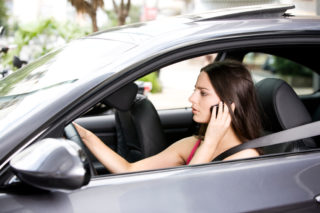
See the above photo?
Remind you of anyone?
Let’s face it: Many of us have used a cell phone while driving.
In fact, an estimated 11 percent of drivers at any one time are using a cell.
But such “distracted driving’’ is dangerous. The National Highway Traffic Safety Administration says nearly 6,000 people died in crashes in 2008 involving reports of distracted driving. NHTSA also estimates up to 30 percent of crashes nationally are at least partly linked to distracted motorists.
Distracted driving, though, is just one factor in highway deaths.
The number of motor vehicle fatalities has been dropping, both in Georgia and nationally, due to factors such as increased seat belt use. Yet with about 33,000 U.S. highway deaths per year, traffic safety is a largely unrecognized public health problem, says Jacob Nelson, director of traffic safety policy and research for the American Automobile Association (AAA).
Motor vehicle accidents claim more lives than any other kind of transportation accident, yet no federal system exists for enforcing safety standards. Regulations have been left up to states, which have been both inconsistent and resistant, according to a recent investigation by News21 and the Center for Public Integrity.
States have a hodgepodge of laws. A North Dakota teen, for example, can get a driver’s license at age 14.
“Some states have motor vehicle death rates that match those in Third World countries,’’ Nelson says.
Georgia’s driving laws and their enforcement are in the middle of the pack among states, says Bob Wilson, director of the Georgia chapter of the National Safety Council. The state has a higher rate of motor vehicle fatalities than the national average.
Meanwhile, the U.S. has a higher rate of motor vehicle deaths than most other developed countries, Nelson says.
Crashes are the leading cause of death for Americans ages 1 through 34.
‘Winnable battle’
The CDC has identified reducing injuries from motor vehicle crashes as a “winnable battle.’’ Increased seat belt use, driving restrictions on teenagers, and adoption of ignition interlock strategies for drunken drivers, among other strategies, can significantly affect the nation’s health, says CDC Director Thomas Frieden.
Distracted driving concerns have recently increased due to media reports and advocacy work. The latter includes a grass-roots group, FocusDriven, a nonprofit formed by Jennifer Smith, who lost her mother in 2008 to a distracted driver.
AAA’s Nelson cites a 2010 poll that found 52 percent of Americans say driving feels less safe than it did five years ago, up from 35 percent feeling less safe in a 2009 poll.
Georgia’s Legislature last year took a step against distracted driving by approving a bill to ban text messaging while driving.
The fight for the legislation was led by the family of Caleb Sorohan, 18, who died in a Morgan County accident while texting. The family lobbied the General Assembly hard in the wake of Sorohan’s 2009 death.
“We wanted to try to keep it from happening to another family,’’ says Caleb Sorohan’s mother, Mandi Sorohan.
The family also wanted to include a ban on talking on the phone while driving, she says.
“People really don’t think it’s dangerous,’’ she says. “But all the studies say it’s dangerous.’’
A University of Utah driving simulator study found drivers using cell phones are just about as impaired as drivers at the legal alcohol intoxication limit.
Hands-free phones
A handful of states have passed laws that ban handheld cell phone use while driving, but none has a prohibition on hands-free phones.
Yet the National Safety Council, citing studies, says hands-free devices don’t eliminate cognitive distraction.
A bill to ban handheld cell use quietly died in the Georgia General Assembly this year.
Hands-free phones are not safer, says Wilson of the National Safety Council. “The conversation is the distraction, not the phone,’’ he says.
Wilson says Georgia’s driving laws include some strong measures, such its motorcycle helmet requirement. Motorcyclists’ deaths jumped by about 25 percent in Florida after the state weakened its helmet law, AAA says.
The state has a moderately tough teen driving law, Wilson says, with a ban on cell phone use, a limit on passengers, a full seat belt requirement and a curfew. The restrictions aren’t as tough as other states’ laws, he says.
And the General Assembly did ‘’a very good thing’’ this year by requiring a car booster seat for children up to age 8, he says.

